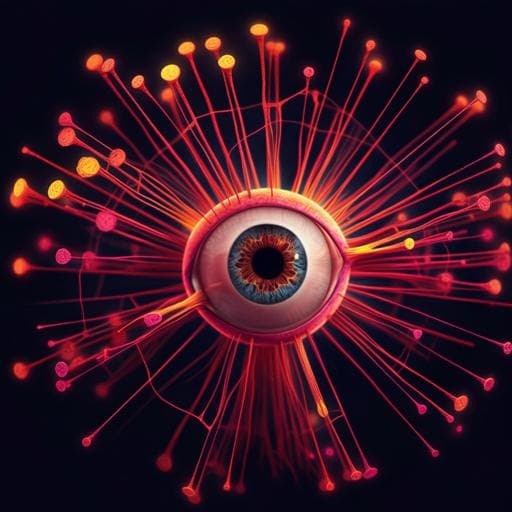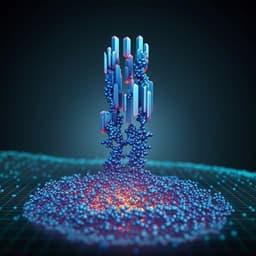
Medicine and Health
Convolutional neural network-based classification of glaucoma using optic radiation tissue properties
J. Kruper, A. Richie-halford, et al.
This groundbreaking study explores how glaucoma affects brain connections, utilizing diffusion MRI to compare 905 glaucoma patients with 5292 healthy individuals. The authors found that convolutional neural networks focusing on optic radiations outperform traditional models in classifying glaucoma, revealing a unique signature in optic radiation tissue. Conducted by a multidisciplinary team from universities and hospitals, this research sheds light on an unexpected link between eye health and brain connectivity.
~3 min • Beginner • English
Introduction
Glaucoma, the leading cause of irreversible blindness, causes retinal ganglion cell death and disrupts transmission of visual information from the retina through the optic nerve to the lateral geniculate nucleus (LGN). The optic radiations (OR) carry signals from the LGN to visual cortex and may undergo changes when deprived of normal sensory input. The key research question is whether glaucoma—by altering peripheral sensory input—leads to measurable changes in central white matter pathways, specifically the OR, and whether these changes resemble accelerated aging. The study investigates if diffusion MRI-derived tissue properties along the OR contain a discriminative signature of glaucoma and whether this signature is specific to the visual system and distinct from aging or other retinal diseases (e.g., AMD).
Literature Review
Prior diffusion MRI (dMRI) studies in glaucoma report heterogeneous and sometimes conflicting findings, with some changes extending beyond visual pathways, suggesting broader brain alterations. Automated Fiber Quantification (AFQ) can extract tract profiles of tissue properties along white matter tracts. With multi-shell dMRI, Diffusional Kurtosis Imaging (DKI) yields complementary measures (FA, MD, MK) sensitive to microstructural changes. Machine learning, particularly CNNs, can capture high-dimensional and non-linear patterns along tracts but require large datasets. The UK Biobank (UKBB) provides sufficient scale to apply ML while mitigating confounds via statistical matching, addressing limitations of smaller heterogeneous samples in prior work.
Methodology
Study design and data access: De-identified MRI and health data were obtained from the UK Biobank (approved under 11/NW/0382). This secondary analysis of de-identified data was exempt from additional IRB review. Inclusion required dMRI acquisition and, when available, visual acuity logMAR ≤ 0.3.
Datasets and matching: From UKBB, 905 participants self-reporting glaucoma (field 6119) and 5292 controls reporting no eye problems (field 6148) were identified. To reduce confounding by age, sex, ethnicity, and socioeconomic status (Townsend Deprivation Index, TDI), statistical matching was performed using Mahalanobis distance and a linear-sum assignment algorithm, retaining pairs with distance ≤ 0.3. This produced dataset A: 856 glaucoma and 856 matched controls (age: both 68 ± 6). Dataset A was split into train/validation/test as 64%/16%/20%, with matched pairs assigned together. Two additional held-out test sets assessed generalization: dataset A.1 (AMD; 78 matched pairs) and dataset A.2 (aging; 166 matched pairs of exactly 70-year-olds vs approximately 60-year-olds). A separate age-group dataset B sampled controls aged 70–79 (N=962) matched to controls ~10 years younger, yielding 819 matched pairs; splits identical to A. Additional test sets for B were B.1 (glaucoma ages 60–64; 142 matched pairs) and B.2 (AMD; 80 matched pairs). There was no train–test overlap across tasks.
MRI acquisition and preprocessing: UKBB dMRI: 2×2×2 mm3 resolution, TE/TR=14.92/3600 ms, b-values: 5 volumes b=0 (AP), 50 volumes b=1000 s/mm2, 50 volumes b=2000 s/mm2; plus 6 b=0 (PA) for EPI distortion correction. Preprocessing included eddy current and head motion correction (FSL eddy with outlier slice correction), gradient distortion correction, and non-linear registration to MNI with FNIRT.
Tractography and tractometry: Using pyAFQ, the OR and two control tracts (corticospinal tract, CST; uncinate fasciculus, UNC) were delineated per subject via ROI-based filtering of GPU-accelerated residual bootstrap tractography seeded within inclusion ROIs; atlas priors aided CST/UNC identification. OR recognition required that streamlines: (1) not cross midline; (2) pass within 3 mm of both inclusion ROIs; (3) avoid exclusion ROI by ≥3 mm; (4) terminate within 3 mm of thalamic and V1 endpoint ROIs. Standard AFQ cleaning removed outlier streamlines. DKI (implemented in DIPY) provided FA, MD, and MK along each tract. Tract profiles were sampled at 100 nodes; the first and last 10 nodes were excluded to reduce partial volume, leaving 80 nodes for analysis.
Machine learning models: Three separate models (one per bundle) were trained.
- CNN: A 1D residual CNN (per Fawaz et al.) with 3 residual blocks (kernel sizes 8, 5, 3; filters 64, 128, 128; BatchNorm and ReLU; residual connections). Inputs were 1D profiles of length 80 with 6 channels (FA, MD, MK for left and right hemispheres). Features were z-scored. Missing bundles were imputed with the mean profile (computed separately in train/test). Models trained on dataset A for glaucoma classification; analogous models trained on dataset B for age-group classification.
- Logistic regression: L2-regularized logistic regression (scikit-learn liblinear). To mitigate overfitting, every other node from the 20th to 78th (inclusive) was used, yielding 30 positions per hemisphere. With 3 tissue properties and both hemispheres, this produced 180 features. Regularization strength was tuned on the validation set.
Evaluation and statistics: Performance was assessed via ROC AUC on held-out test sets. For visual system tests (datasets A and B), OR AUCs were compared to CST and UNC using DeLong’s test with FDR correction (significance at corrected p<0.05). For generalization tests (A.1, A.2, B.1, B.2), 95% CIs were computed from DeLong variance with Bonferroni correction across three bundles; AUC considered significant if corrected CI excluded 0.5. Sensitivity analyses included restricting to subjects with all bundles recognized to assess potential bias from missing tract identifications.
Key Findings
- Group differences in tract profiles: In dataset A, glaucoma subjects showed lower MK across the OR and regionally lower FA and higher MD in posterior OR, with slightly higher FA and lower MD in anterior OR. Differences were statistically significant due to large N but distributions overlapped substantially. Some small differences were also present in non-visual tracts (UNC, CST), indicating mean differences are not specific to visual pathways.
- CNN glaucoma classification (dataset A): OR-based CNN achieved AUC=0.69, significantly above chance and significantly higher than CNNs trained on CST (AUC=0.57; DeLong p=0.0028) and UNC (AUC=0.53; p=0.0002). Control-bundle AUCs were not significantly above chance. Results were similar when restricting to subjects with all bundles recognized. Bundle detection rates in dataset A: UNC L/R 100.0%/100.0%; CST L/R 99.8%/99.8%; OR L/R 95.8%/94.9%.
- Logistic regression: OR logistic model AUC=0.63 (significantly above chance); CST AUC=0.57; UNC AUC=0.54. OR AUC was marginally higher than UNC (p=0.0431) and not significantly different from CST. OR CNN outperformed OR logistic regression marginally (AUC 0.69 vs 0.63; DeLong p=0.0303), indicating possible non-linear effects but modest practical gain.
- Generalization tests: Glaucoma-trained CNN did not generalize to AMD (dataset A.1: OR AUC=0.53; CST=0.45; UNC=0.43; none significant) or to age-group classification (dataset A.2: OR AUC=0.51; CST=0.54; UNC=0.53; none significant). Age-trained CNNs (dataset B) achieved AUCs 0.61–0.64 across OR/CST/UNC without significant differences between bundles, and did not generalize to glaucoma (dataset B.1: OR=0.50; CST=0.50; UNC=0.53) or AMD (dataset B.2: OR=0.43; CST=0.43; UNC=0.42). Overall, an OR-specific glaucoma signature was detected, distinct from aging and not transferable to AMD in this dataset.
Discussion
The study demonstrates that diffusion MRI-derived tissue properties along the optic radiations carry a detectable, tract-specific signature of glaucoma. While average group differences are small and overlapping, a CNN leveraging the full tract profiles identifies glaucoma above chance only when using OR data, not non-visual tracts, suggesting specificity to the visual system. The marginal advantage of the CNN over linear models indicates some non-linear relationships, though effect sizes are modest. Importantly, the glaucoma-related OR signature did not generalize to age-group classification or to AMD, and age-related changes were equally present in visual and non-visual tracts—evidence against the hypothesis that glaucoma effects simply reflect accelerated aging of white matter. Potential mechanisms include downstream reorganization due to altered visual input and/or transsynaptic degeneration via the LGN, consistent with reports of reduced LGN volume in glaucoma. The lack of generalization to AMD may reflect differences in disease mechanisms, mild AMD cases in UKBB, or insufficient power. The findings emphasize the importance of tract-specific analyses and large, well-matched cohorts to detect subtle disease effects, while highlighting limits of cross-disease generalization and the need for interpretable models and multimodal data integration.
Conclusion
Using large-scale UK Biobank dMRI with rigorous matching and automated tractometry, the study shows that glaucoma is associated with a distinct, likely non-linear pattern of tissue properties along the optic radiations, enabling above-chance classification with CNNs and, to a lesser extent, linear models. These effects appear specific to the visual pathway and do not resemble normal aging, nor do they generalize to AMD within this dataset. Future work should: (1) extend analyses to additional visual pathway segments (e.g., optic tract/nerve) and apply alternative microstructural models (e.g., NODDI) and architectures or normative modeling; (2) integrate clinical measures (e.g., OCT) and richer covariates to address heterogeneity and confounds; (3) test generalization to related neurodegenerative conditions (e.g., Alzheimer’s disease) in larger datasets; and (4) develop algorithms to stratify glaucoma subtypes and severity to refine associations with white matter changes.
Limitations
- Diagnosis by self-report for glaucoma and AMD may introduce misclassification (false positives/negatives) and heterogeneity in subtype, severity, and duration; common co-morbid eye conditions may add noise.
- The study is correlational; residual confounding (e.g., cardiovascular, metabolic, lifestyle, genetic factors) may remain despite matching on age, sex, ethnicity, and TDI.
- dMRI limitations include sensitivity to crossing fibers and inability to distinguish feedforward vs. feedback projections; OR tractography can fail due to curvature and intersections, leading to missing tracts in some subjects.
- AMD generalization analyses were limited by smaller sample sizes and predominantly mild cases, potentially underpowering detection of shared signatures.
- Modest AUCs indicate limited clinical utility at present; CNN gains over linear models were marginal and less interpretable.
- The analysis focused on OR, CST, and UNC; effects in other visual pathway components were not assessed.
Related Publications
Explore these studies to deepen your understanding of the subject.







